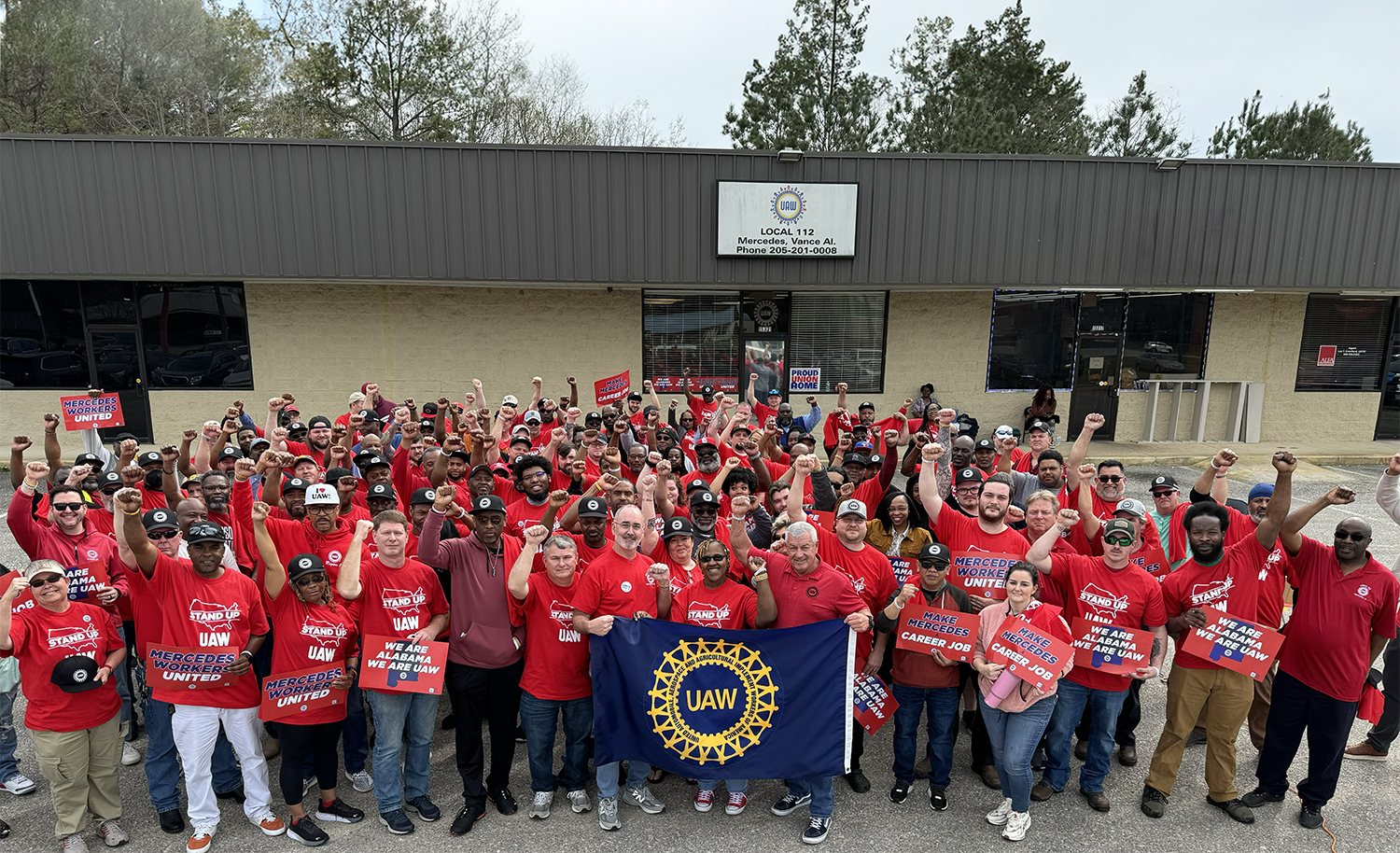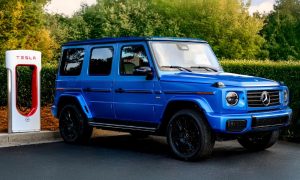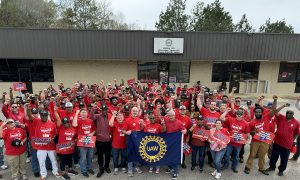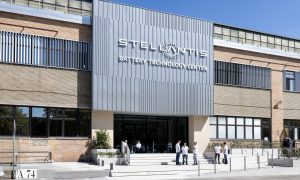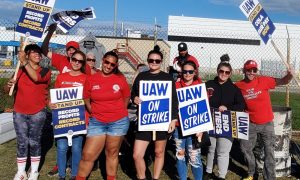Mercedes-Benz workers at a factory in Alabama have begun voting on whether to join the United Auto Workers (UAW) this week, after the union was voted in at a Volkswagen plant in Tennessee a few weeks ago.
On Monday, Mercedes workers began voting on UAW membership at the company’s factory in Tuscaloosa, Alabama, with voting remaining open until Friday. The vote comes after a majority of workers at the Mercedes plant in February voted to hold a union vote, and after Volkswagen employees officially voted to recognize the UAW at the company’s factory in Chattanooga, Tennessee, last month.
The Mercedes vote is thought to be much less of a sure-fire victory for the union, especially with the automaker specifically telling workers that they should vote no through flyers and signage, as Reuters reports. The outlet also alleges that Mercedes hired anti-union companies to come speak at the plant, though the automaker has denied that it is using union-busting tactics at the factory.
“Mercedes-Benz U.S. International (MBUSI) fully respects our Team Members’ choice whether to unionize and we look forward to participating in the election process to ensure every Team Member has a chance to cast their own secret-ballot vote, as well as having access to the information necessary to make an informed choice,” a Mercedes spokesperson told Teslarati in an email.
“MBUSI has a strong record of success over the past 25+ years operating as One Team in Alabama. Our primary focus at MBUSI is always to provide a safe and supportive work environment for our Team Members, so they can continue to build safe and superior vehicles for the world. We believe open and direct communication with our Team Members is the best path forward to ensure continued success.”
Below, you can see the voting schedule for workers at the Mercedes factory, with the ballots set to be counted after polls close on Friday morning.
Credit: UAW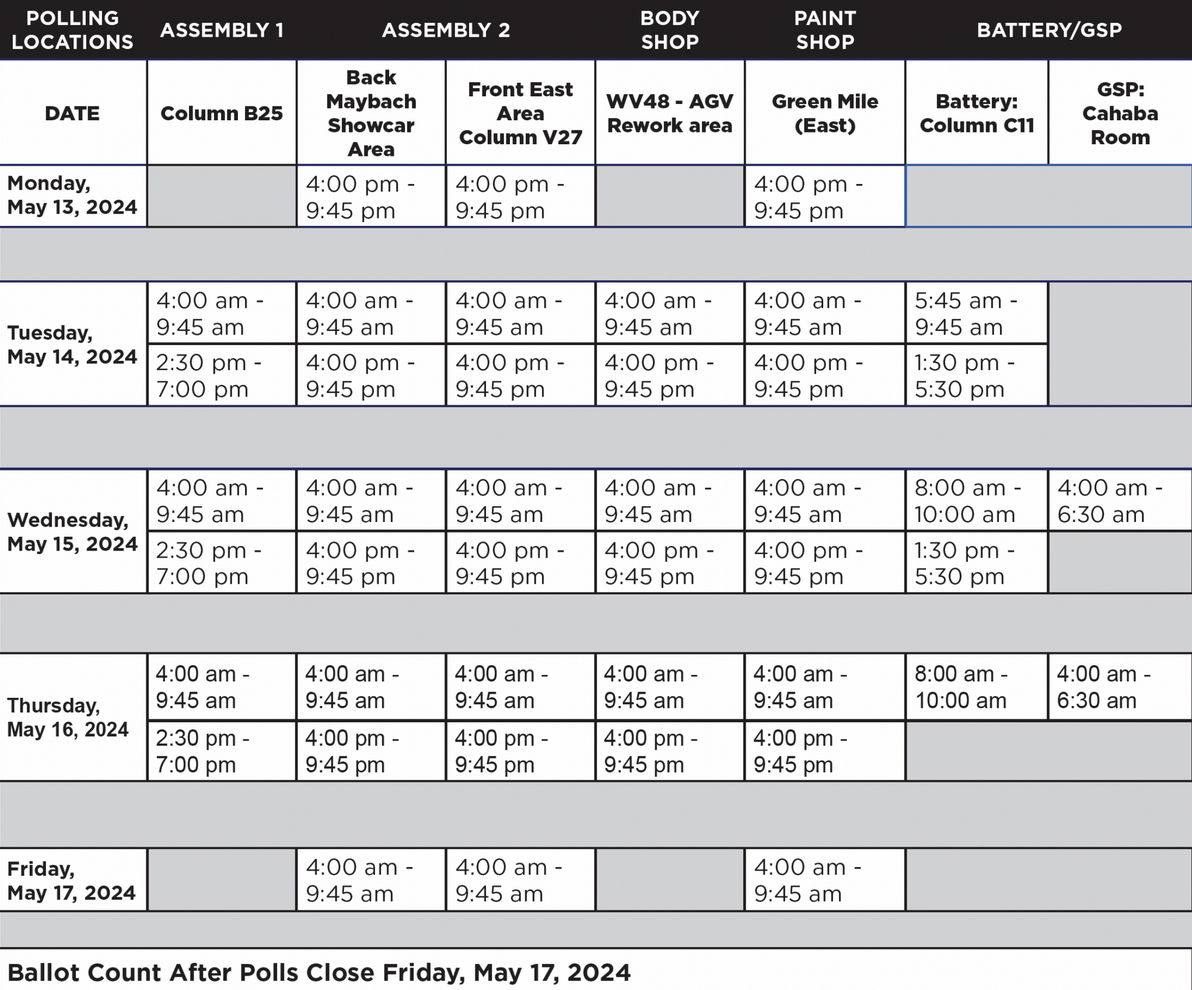
A spokesperson from the company told Reuters that Mercedes-Benz respects worker unionization efforts, adding that the company is making sure that each worker can vote secretly, while having all the details necessary to cast an informed vote.
“That is the biggest thing that we’re using to push because we can show how much the union can win now,” Mercedes employee Jacob Ryan told Reuters. Ryan adds that he supports the union due to the automaker’s failure to address worker concerns such as pay, hours, and benefits.
The employee has been at the factory for around five years, and under two years ago, he witnessed the plant struggling to get 20 percent of workers to file for a union election. To reach the point of holding a National Labor Relations Board (NLRB) election, as is now happening, the UAW says it waits for a facility to reach a 70-percent threshold of workers filing in favor of a vote.
The Alabama Mercedes plant produces the electric EQS and EQE lineups, as well as the gas GLE and GLS vehicles, according to the company’s website. The automaker also says it employed 6,100 workers in 2023, with around 295,000 vehicles produced there in the same year.
Although the Volkswagen plant had voted not to be recognized by the UAW twice before voting to join the union last month, this is the first time that a union election has been held at the Tuscaloosa Mercedes factory.
Following the UAW’s historic six-week strikes of Ford, General Motors (GM), and Stellantis last year, which ultimately garnered record pay increases for workers, the union announced a campaign at several other non-unionized facilities. In addition to Volkswagen and Mercedes, the UAW announced plans to launch organizing efforts at Tesla, Rivian, and nine other automakers.
During the strikes, UAW President Shawn Fain also called employees at Tesla, Toyota and other automakers “members of the future,” later saying he hoped to bargain with the “Big Five or Six” in 2028, rather than just the Big Three.
What are your thoughts? Let me know at zach@teslarati.com, find me on X at @zacharyvisconti, or send us tips at tips@teslarati.com.
News
Tesla launches in India with Model Y, showing pricing will be biggest challenge
Tesla finally got its Model Y launched in India, but it will surely come at a price for consumers.

Tesla has officially launched in India following years of delays, as it brought its Model Y to the market for the first time on Tuesday.
However, the launch showed that pricing is going to be its biggest challenge. The all-electric Model Y is priced significantly higher than in other major markets in which Tesla operates.
On Tuesday, Tesla’s Model Y went up for sale for 59,89,000 rupees for the Rear-Wheel Drive configuration, while the Long Range Rear-Wheel Drive was priced at 67,89,000.
This equates to $69,686 for the RWD and $78,994 for the Long Range RWD, a substantial markup compared to what these cars sell for in the United States.
🚨 Here’s the difference in price for the Tesla Model Y in the U.S. compared to India.
🚨 59,89,000 is $69,686
🚨 67,89,000 is $78,994 pic.twitter.com/7EUzyWLcED— TESLARATI (@Teslarati) July 15, 2025
Deliveries are currently scheduled for the third quarter, and it will be interesting to see how many units they can sell in the market at this price point.
The price includes tariffs and additional fees that are applied by the Indian government, which has aimed to work with foreign automakers to come to terms on lower duties that increase vehicle cost.
Tesla Model Y seen testing under wraps in India ahead of launch
There is a chance that these duties will be removed, which would create a more stable and affordable pricing model for Tesla in the future. President Trump and Indian Prime Minister Narendra Modi continue to iron out those details.
Maharashtra Chief Minister Devendra Fadnavis said to reporters outside the company’s new outlet in the region (via Reuters):
“In the future, we wish to see R&D and manufacturing done in India, and I am sure at an appropriate stage, Tesla will think about it.”
It appears to be eerily similar to the same “game of chicken” Tesla played with Indian government officials for the past few years. Tesla has always wanted to enter India, but was unable to do so due to these import duties.
India wanted Tesla to commit to building a Gigafactory in the country, but Tesla wanted to test demand first.
It seems this could be that demand test, and the duties are going to have a significant impact on what demand will actually be.
Elon Musk
Tesla ups Robotaxi fare price to another comical figure with service area expansion
Tesla upped its fare price for a Robotaxi ride from $4.20 to, you guessed it, $6.90.

Tesla has upped its fare price for the Robotaxi platform in Austin for the first time since its launch on June 22. The increase came on the same day that Tesla expanded its Service Area for the Robotaxi ride-hailing service, offering rides to a broader portion of the city.
The price is up from $4.20, a figure that many Tesla fans will find amusing, considering CEO Elon Musk has used that number, as well as ’69,’ as a light-hearted attempt at comedy over the past several years.
Musk confirmed yesterday that Tesla would up the price per ride from that $4.20 point to $6.90. Are we really surprised that is what the company decided on, as the expansion of the Service Area also took effect on Monday?
But the price is now a princely $6.90, as foretold in the prophecy 😂
— Elon Musk (@elonmusk) July 14, 2025
The Service Area expansion was also somewhat of a joke too, especially considering the shape of the new region where the driverless service can travel.
I wrote yesterday about how it might be funny, but in reality, it is more of a message to competitors that Tesla can expand in Austin wherever it wants at any time.
Tesla’s Robotaxi expansion wasn’t a joke, it was a warning to competitors
It was only a matter of time before the Robotaxi platform would subject riders to a higher, flat fee for a ride. This is primarily due to two reasons: the size of the access program is increasing, and, more importantly, the service area is expanding in size.
Tesla has already surpassed Waymo in Austin in terms of its service area, which is roughly five square miles larger. Waymo launched driverless rides to the public back in March, while Tesla’s just became available to a small group in June. Tesla has already expanded it, allowing new members to hail a ride from a driverless Model Y nearly every day.
The Robotaxi app is also becoming more robust as Tesla is adding new features with updates. It has already been updated on two occasions, with the most recent improvements being rolled out yesterday.
Tesla updates Robotaxi app with several big changes, including wider service area
News
Tesla Model Y and Model 3 dominate U.S. EV sales despite headwinds
Tesla’s two mainstream vehicles accounted for more than 40% of all EVs sold in the United States in Q2 2025.

Tesla’s Model Y and Model 3 remained the top-selling electric vehicles in the U.S. during Q2 2025, even as the broader EV market dipped 6.3% year-over-year.
The Model Y logged 86,120 units sold, followed by the Model 3 at 48,803. This means that Tesla’s two mainstream vehicles accounted for 43% of all EVs sold in the United States during the second quarter, as per data from Cox Automotive.
Tesla leads amid tax credit uncertainty and a tough first half
Tesla’s performance in Q2 is notable given a series of hurdles earlier in the year. The company temporarily paused Model Y deliveries in Q1 as it transitioned to the production of the new Model Y, and its retail presence was hit by protests and vandalism tied to political backlash against CEO Elon Musk. The fallout carried into Q2, yet Tesla’s two mass-market vehicles still outsold the next eight EVs combined.
Q2 marked just the third-ever YoY decline in quarterly EV sales, totaling 310,839 units. Electric vehicle sales, however, were still up 4.9% from Q1 and reached a record 607,089 units in the first half of 2025. Analysts also expect a surge in Q3 as buyers rush to qualify for federal EV tax credits before they expire on October 1, Cox Automotive noted in a post.
Legacy rivals gain ground, but Tesla holds its commanding lead
General Motors more than doubled its EV volume in the first half of 2025, selling over 78,000 units and boosting its EV market share to 12.9%. Chevrolet became the second-best-selling EV brand, pushing GM past Ford and Hyundai. Tesla, however, still retained a commanding 44.7% electric vehicle market share despite a 12% drop in in Q2 revenue, following a decline of almost 9% in Q1.
Incentives reached record highs in Q2, averaging 14.8% of transaction prices, roughly $8,500 per vehicle. As government support winds down, the used EV market is also gaining momentum, with over 100,000 used EVs sold in Q2.
Q2 2025 Kelley Blue Book EV Sales Report by Simon Alvarez on Scribd
-

 News3 days ago
News3 days agoTesla debuts hands-free Grok AI with update 2025.26: What you need to know
-

 Elon Musk6 days ago
Elon Musk6 days agoxAI launches Grok 4 with new $300/month SuperGrok Heavy subscription
-

 Elon Musk1 week ago
Elon Musk1 week agoElon Musk confirms Grok 4 launch on July 9 with livestream event
-

 News2 weeks ago
News2 weeks agoTesla Model 3 ranks as the safest new car in Europe for 2025, per Euro NCAP tests
-

 Elon Musk2 weeks ago
Elon Musk2 weeks agoxAI’s Memphis data center receives air permit despite community criticism
-

 News5 days ago
News5 days agoTesla begins Robotaxi certification push in Arizona: report
-

 Elon Musk2 weeks ago
Elon Musk2 weeks agoTesla reveals it is using AI to make factories more sustainable: here’s how
-

 Elon Musk2 weeks ago
Elon Musk2 weeks agoTesla scrambles after Musk sidekick exit, CEO takes over sales

